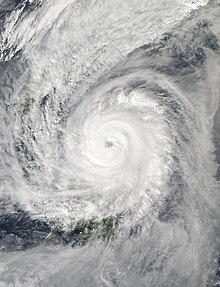
Back 令和元年台風第28号 Japanese 태풍 간무리 (2019년) Korean Tufão Kammuri Portuguese Каммури (тайфун) Russian Typhoon Kammuri SIMPLE Bagyong Tisoy Tagalog Каммурі (тайфун) Ukrainian Bão Kammuri (2019) Vietnamese 颱風北冕 (2019年) Chinese Hong-thai Kammuri (2019 nî) ZH-MIN-NAN
 Kammuri prior to peak intensity on December 2 | |
| Meteorological history | |
|---|---|
| Formed | November 24, 2019 |
| Dissipated | December 6, 2019 |
| Very strong typhoon | |
| 10-minute sustained (JMA) | |
| Highest winds | 165 km/h (105 mph) |
| Lowest pressure | 950 hPa (mbar); 28.05 inHg |
| Category 4-equivalent typhoon | |
| 1-minute sustained (SSHWS/JTWC) | |
| Highest winds | 220 km/h (140 mph) |
| Lowest pressure | 938 hPa (mbar); 27.70 inHg |
| Overall effects | |
| Fatalities | 17 |
| Damage | $130 million (2019 USD) |
| Areas affected | Caroline Islands, Mariana Islands, Philippines |
| IBTrACS | |
Part of the 2019 Pacific typhoon season | |
Typhoon Kammuri, known in the Philippines as Typhoon Tisoy, was a powerful typhoon which impacted the Philippines in early December 2019. Kammuri, which means crown or Corona Borealis in Japanese, the twenty-eighth named storm and sixteenth typhoon of the 2019 Pacific typhoon season, Kammuri developed from a tropical wave situated a couple hundred kilometers south of the Mariana Islands. From November 25 to 27, the system tracked westward at a steady pace and rate of intensification, first making minor impacts in Guam. On November 28, the system intensified into a typhoon as environmental conditions became marginally conducive for significant development. From November 29 to December 1, Kammuri was unable to strengthen to previous estimates due to its near stationary movement as a result of weak steering currents, upwelling itself consequently. On December 2, the system tracked westward at a much faster speed of 19 km/h (12 mph) and rapidly intensified over warm Philippine Sea waters, before making landfall in the Bicol Region of the Philippines at peak intensity as a category 4-equivalent typhoon.
Upon leaving the Philippines, Kammuri significantly weakened as wind shear increased and interaction with the Philippine islands caused the structure of the system to degrade rapidly, and throughout December 3, it stayed as a category 1-equivalent typhoon, with its outer rainbands barely on land. By December 4, Kammuri drifted over the South China Sea as a weakening tropical storm. Through December 5 and 6, Kammuri weakened significantly and its low-level circulation center became exposed; as a result, it dissipated on December 6.